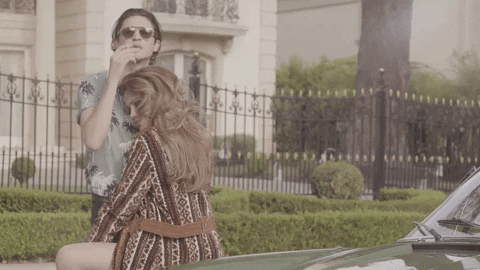Table of Contents
It’s that time of year again – when Valentine’s Day looms in the back of our minds like an ancient migratory instinct, stirring up feelings as old as our gathering ancestors. It arrives with its familiar constellation of questions for sensitive singles: “How should I feel? What do I feel?” These questions echo louder at a time when we’re questioning everything from gender norms to capitalism’s grip on our emotions.
In 2025, as we navigate a world where traditional norms dissolve or trend, ultimately reshape themselves daily, Valentine’s Day is a curious artifact of our collective idyllic past. From those first paper hearts in elementary school to the dozen roses that still symbolize romance, this holiday has deeply woven into our cultural fabric – for better or worse.
We all want to celebrate ‘LOVE’, which seems harmless. But what does a holiday built on traditional expressions of love mean in an era where we’re dismantling old structures of gender, relationship, and capitalism? As mental health awareness grows, social media amplifies both connection and isolation. Does Valentine’s Day affect our collective psyche in increasingly complex ways?
The Weight of Digital Love
Picture this: It’s February 14th, and your Instagram feed transforms into a highly curated theater of romance. Between the carefully angled shots of $200 prix fixe dinners at that new farm-to-table spot (you know, the one with the living wall and natural wine list) and the strategically scattered rose petals framing Cartier boxes, modern Valentine’s Day has evolved simple date night into a complex performance art. Even the algorithm knows it’s showtime, serving up an endless stream of #couplegoals against sunset-lit city skylines.
In an era where we casually drop terms like “trauma-informed boundaries” and “toxic positivity” into brunch conversations, the pressure to participate in this romantic spectacle weighs particularly heavy on those managing depression. The intersection of social media and Valentine’s Day has created what psychologists call a “comparative anxiety spiral” – a perfect storm where personal worth gets tangled up with digital validation. Having a partner is no longer enough; they need to understand attachment theory, practice mindful communication, AND know their love language while orchestrating Instagram-worthy moments. Your neighborhood coffee shop’s oat milk latte arrives with an artisanal heart design (and a gentle reminder to tag them), while your DMs fill with targeted ads from sustainable brands promising that their new “self-love collection” will heal your inner child. Has commercialization gotten more inclusive, co-opting the language of mental health and progressive values? Still, the underlying pressure remains – it’s just wearing better packaging and using more elegant but cool fonts.
The Social Media Revolution of Love: How Digital Culture Transformed Valentine’s Day
Social media has dramatically reshaped The landscape of love, with ‘TOKtherapy’ and Instagram psychology revolutionizing how we discuss, understand, and celebrate relationships. What began as casual TikTok relationship advice has evolved into a full-scale reimagining of Valentine’s Day, forcing brands to adapt to a new era of digital-native emotional intelligence.
Consider Headspace’s groundbreaking collaboration with John Legend in 2022. When an EGOT winner trades romantic ballads for meditation guides, it signals more than a marketing pivot – it represents a fundamental shift in how we approach love and self-care. Their VP of global brand marketing, Amy Davis, captured this transformation perfectly: “The most important relationship we all have: the one with ourselves.”
Major brands have become fluent in this new emotional vocabulary with remarkable speed. Luxury retailers now market their Valentine’s collections as “self-actualization tools” rather than mere gifts – that designer bracelet isn’t just jewelry, it’s a “talisman of personal growth.” The dating app ecosystem perhaps best illustrates this evolution. February’s algorithmic surge now comes wrapped in psychological sophistication. Hinge’s promise to “delete itself after finding authentic connection” and Bumble’s rebranding as a “mindful dating journey” showcase how traditional romance marketing has been replaced by wellness-focused messaging. Yet beneath the polished UX and inclusive imagery, these platforms still fundamentally suggest that being single is a problem to be solved – just now with better typography and more therapeutic language.
Market research shows younger generations increasingly prioritizing non-traditional Valentine’s celebrations, seeking authentic representations of diverse relationship styles and self-love practices. The success of initiatives like Legend’s 45-minute Sleepcast and curated playlists demonstrates how brands extend beyond the holiday, creating year-round conversations about love, wellness, and personal growth.
As we move forward, the question isn’t whether this inclusive, wellness-focused approach to Valentine’s Day will continue – it’s how much further it will evolve. Are we witnessing the end of traditional romance marketing or its transformation into something more nuanced and meaningful? As digital culture continues to reshape our understanding of love and connection, one thing is clear: brands must either evolve with these changes or risk becoming as outdated as paper Valentine’s cards in a digital world.
When Valentine’s Day Meets Mental Health: A More Complex Picture
Living with depression during Valentine’s season creates a unique kind of emotional turbulence. While social media floods with messages of self-love and celebration, depression has its way of rewriting these narratives. The algorithms don’t know when to stop serving up couple photos, self-care routines, and “empowering” singles content – each post potentially becoming another reminder of the gap between societal expectations and personal reality.
The mental health awareness movement has paradoxically created its pressures. Today’s Valentine’s marketing, though well-intentioned with its emphasis on self-love and authenticity, can inadvertently set up new standards to fall short of. The “radical self-love” movement, while meaningful for many, sometimes feels like adding another item to an impossible checklist: not only should you be partnered or content being single, but you should also be thriving in your solitude, posting about your self-care routine, and radiating inner peace.
Depression doesn’t just affect how we feel about relationships – it colors how we interpret thing. Every “love yourself“ post, every meditation app advertisement, and every well-meaning message about finding joy in solitude and finding oneself. Even Justin Bieber sings to their destructive ex, “To go ahead and love yourself.” When your brain is already struggling with fundamental self-worth, being bombarded with messages about embracing your “authentic self” can feel less like liberation and more like witnessing a party you can’t seem to join.
Reframing February 14th: Love Gets an Upgrade.
As we approach Valentine’s Day, the voices of wellness will get interesting. The same wave that normalized therapy TikToks and made mental health conversations mainstream has blown open dialogues we never imagined having – normalizing conversations around the raw edges of loneliness, the complexity of human connection, and the beautiful mess of being REAL in a filtered world.
Watch how LGBTQ+ communities have been quietly revolutionizing the holiday, transforming it through “chosen family” celebrations that flip the script on what love can look like. These gatherings – sometimes chaotic, always authentic – show what happens when people ditch the Hallmark Card handbook and write their own rules. Similar energy radiates from the growing embrace of polyamory, aromantic relationships, and the radical act of celebrating ride-or-die friendships with the same energy once reserved for rom-com-style romance.
These aren’t just wholesome side notes to the traditional Valentine’s narrative – they’re early signals of a seismic shift. As our understanding of human connection breaks free from the confines of coupled romance, Valentine’s Day stands ready to evolve into something far more interesting than its greeting card origins ever dreamed: a celebration of love in all its wild, wonderful, and deliciously complicated forms.
The future of February 14th might look less like a predetermined script and more like a blank canvas, waiting for each person to paint their definition of connection. And let’s be honest – that’s a way more intriguing holiday than the one we inherited from our local drugstore’s seasonal aisle.
A New Valentine’s Day: Your Holiday, Your Rules
Perhaps the real revolution of Valentine’s Day isn’t about rejection or resistance – it’s about radical permission. Permission to experience February 14th in whatever way nourishes your soul and nervous system. Whether that means wrapping yourself in weighted blankets for a day of intentional rest, hosting a chaotic karaoke night with your chosen family, sharing a quiet meal with someone special, or simply acknowledging that you’re doing your best on a day that feels heavy – it’s all valid, it’s all love, and it’s all worthy of celebration.
The future of Valentine’s Day isn’t about prescribing new rules to replace the old ones. It’s about creating space for each person to honor love – in all its messy, beautiful, complicated forms – in genuine and life-giving ways. Because when we strip away the commercial pressure and social expectations, that’s what this holiday has always been trying to celebrate: our fundamental human need for connection, including the vital connection with ourselves.
Gif banner by Art Love GIF by Kimberly Cole

